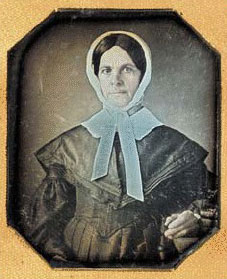- Relief printing
- Intaglio and planographic printing
- Color printing
- Bits and pieces
- Early photography in silver
- Non-silver processes
- Modern photography
- Color notes
- Color photography
- Photography in ink: relief and intaglio printing
- Photography in ink: planographic printing
- Digital processes
- Where do we go from here?
Early Photography in Silver

Daguerreotype. Photographer unknown. Portrait of a woman. c. 1858. 3 5/8 x 2 3/4" (9.2 x 7 cm). The Museum of Modern Art, New York. Gift of Richard Benson.
I always like to say that photography had five inventors. We all know three: Niépce, Daguerre, and Talbot. A fourth, my favorite because of his pictures, is the Frenchman Hippolyte Bayard, who invented an autopositive paper process in the early 1840s. The fifth would be Sir John Herschel, a member of that small group of the wealthy English upper class who all seemed to know each other in the mid-nineteenth century. Herschel solved the great problem of how to make photographs permanent, suggesting to Talbot that he “fix” his pictures with the chemical sodium thiosulfate. This compound, and its cousin ammonium thiosulfate, have remained the primary fixing chemicals for nearly all silver-based photographic processes, from the very earliest until those modern chemical processes that are presently disappearing under the digital onslaught.
The invention of photography was formally announced in 1839. During the previous decades, though, many people had worked on the task of capturing an image by the agency of light alone, and as early as 1826, a Frenchman, Joseph Nicéphore Niépce, had made a lens-generated image in hardened asphaltum. What happened in 1839 was that two completely different processes reached a practical state of development that would quickly allow photography to spread throughout society. One method—invented by another Frenchman, Louis Jacques Mandé Daguerre—allowed precise and sharp lens images to be captured on silver-plated sheets of copper. The other method, invented by the Englishman William Henry Fox Talbot, produced rougher images on paper.

